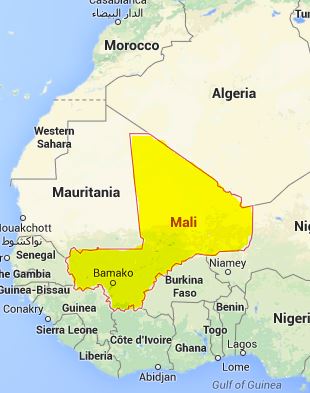Minerals of Mali


Mali is a landlocked country. It is located in the western Africa. Mali is part of Sahara desert and Sudanese savannah land. It is located to the south west of Algeria. The neighbours of Mali are Guinea, Senegal, Mauritania, Algeria, Niger, Burkina Faso and Cote de Ivories. The area of Mali is 1,240,192sq.km. Mali is divided into three zones .The southern cultivated Sudanese Zone, the central Semiarid Sahelian Zone and the northern arid Saharan Zone. The southern part is flat plain. The central part is plateau land and the northern part is hilly land. The north eastern part is full of rugged hills. The elevation may goes up to 1000 meters. The desert and semi-arid lands form around 65 percent of Mali. The Niger river and the Senegal river are two major rivers of Mali. The river Niger is the lifeline of Mali. It provides drinking water, irrigation water, and forms mode of navigation. It is the most important inland water way of western Africa. Niger formed the fertile delta in western Africa. A portion of the delta falls under Mali. The climate of Mali is tropical in south, and arid in the north. There is maximum rainfall in the southern part of Mali. The northern part gets very little amount of rainfall. So it is converted in to desert. The rainfall starts in the month of May and continues up to September. The remaining months are dry and without rain fall. There is deficit rainfall in central and northern part with resulting drought conditions. Continuous failure of crops leads to famine conditions in the past. Heavy rainfall in July and August creates condition of flood in the Niger delta. The lands are exposed to desertification process. Soil erosion is a common problem in Mali. Large scale deforestation continues in the forests with unscientific methods of timber harvesting. Forest fire is regular in the months of March and April. Sand storm occurs in the desert areas with formation of sand dunes in human habitation areas.
The land of Mali is geologically stable and found to be composed of very old rocks. The West African craton is found in the west and the Tuareg shield is found in the south-east Mali. The major rocks are Granite, Sandstone, Gneiss, Schist, Shale and Quartzite. The land is rich in mineral resources. The area was geologically explored during the occupation of French in the early part of 20th century. The location of mineral deposits is identified and the reserves are estimated in the accessible areas. The minerals are bauxite, diamond, copper, iron ore, manganese, gold, silver, uranium, zinc, lithium, phosphates, rock salts, and limestone, gypsum, kaolin and building stones. Granite is used as a quality building stones. Mali is rich in gold deposits. Mining areas of gold are in places like Yatela, Segola, Somilo, Somino, Morila Somiey, Gounkoto, Semoso, Kodieran and Kagaba. Bauxite is found in western part of Mali in Sitadina. The mining of bauxite may start soon. Iron ore is found in Faleima and Teinfala. The deposit is estimated to be around 2 billion tones. Manganese ores are found in Gourma. The deposit is around 20 million tones. Diamond is found i near Keneiba. Phosphates deposits are found in Tilemsi and Bourem.. Mining is started in Tilemsi. Lithium is found in Kaes, Faleima and Bougouri. The deposits of lithium are estimated to be 4 million tones. New areas o gold deposits are found near Keneiba, Medinandi, Diangounte,Diabani,Koflatie, Kalaka, Comana, Finkola,Siribaya and Mininko. The government of Mali implemented the new Mining Code in september 2012. The government is taking care of development of mining sector in Mali. A number of companies from France are active in mineral exploration and mining in Mali. The processing industry is yet to take shape in Mali. The development of road, railway, and power generation is necessary for development of mining and mineral processing industry in Mali.